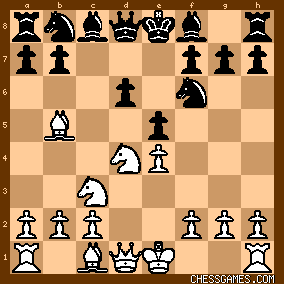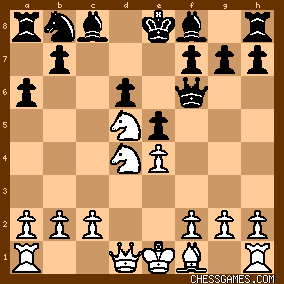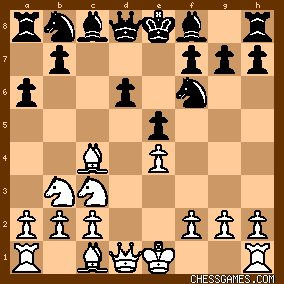|
< Earlier Kibitzing · PAGE 13 OF 14 ·
Later Kibitzing> |
| Mar-26-09 | | parisattack: <pankajdaga: noob question: What is the point of a6 for black? Is it simply to take away the b5 square from the knight or the white bishop?> That, of course. But I think it is more a 'high class waiting move' - Black wants to see how White develops before committing the e-pawn, the Q and perhaps even the QN. It also stops a nasty check against ...e5. |
|
| Mar-26-09 | | MaxxLange: <parisattack> is on to the main idea, at least historically: the idea of the Najdorf variation is to play ...e5. That's not possible after 1 e4 c5 2 Nf3 d6 3 d4 cxd4 4 Nxd4 Nf6 5.Nc3 because 5...e5? 6 Bb5+ is very strong for White Notice that the old main-line move, 6. Bg5, as well as 6 Bc4, both prevent 6...e5. As time has gone on, the move 6...e6 has become much more important to Najdorf theory though, as in Kasparov's play. |
|
| Mar-26-09 | | MaxxLange: Tal vs Darzniek Artur, 1953 is an example of 6 Bg5 e5?! in the Najdorf |
|
| Mar-26-09 | | chessman95: <noob question: What is the point of a6 for black? Is it simply to take away the b5 square from the knight or the white bishop?> That's about it, but the main benefit of this is that it allows you to play ...e5. As <MaxxLange> pointed out, it's unwise to play ...e5 after 1 e4 c5 2 Nf3 d6 3 d4 cxd4 4 Nxd4 Nf6 5.Nc3. The reason is that after Bb5+, 
click for larger viewblack's only options are to block with the bishop (but then white trades bishops and puts the knight on the strong f5), or with the knight on c6 (that just loses a peice), or with the knight on d7 (that again allows the knight to go to the strong f5 because the bishop is blocked). The idea is that once the knight gets to f5 white has the advantage, so to play e5 you must first prevent a check somehow, and ...a6 is the simplist way of doing that. Also, I wanted to point out why ...e5 is bad after the main line Bg5 in the
Najdorf. The reason, as the game showed, is that white can just take the knight. If gxf6 then black's kingside is horrible, but if Qxf6 then that allows the knight to go to the super-strong d5 with tempo 
click for larger viewwhere it can't be removed with pawns any more. After Qd8 and Nb3 
click for larger viewwhite's position is much stronger with that "perfect knight" in just about the strongest spot it could be in. That's why black should play ...e6 after Bg5, so that the knight cannot go to d5. With the pawns commited like that and the King's Knight gone, white should easily be able to build up a strong attack. Also note that in the above position white's lead in development is massive. <MaxxLange> also said that the Fischer Attack (Bc4) prevents e5. I know that e6 is the correct move there, but why is this? After 6...e5 7.Nb3 
click for larger viewI'm guessing the reason is once again that the knight will go to the strong post on d5. Is this correct? |
|
| Mar-26-09 | | MaxxLange: Maybe discourages is the more accurate term - the idea is that the Bc4 will be too strong on the diagonal after 6...e5, I think: and the d5 square is weak |
|
| Mar-26-09 | | chessman95: It does a good job of discouraging it then! Only 5 games in the database! Opening Explorer |
|
| Mar-26-09 | | MaxxLange: here's the best game I can find:
Bronstein vs M Kolon, 1956 |
|
| Mar-26-09 | | MaxxLange: 6 f4 can also be read as an anti-e5 move. 6 Be2 and 6 Be3 allow it, as do, I guess, 6 a4, 6 g3, 6 h3 etc Consider the O'Kelly Sicilian. After 1 e4 c5 2 Nf3 a6!?,
3 d4 is wrong, because Black gets an easy game by simply 3...cxd4 4. Nxd4 e5! So. in that variation, the books advise White to play 3. Nc3 or 3. c3 or some other move to aim for a transposition in which Black's ...a6 is a poor move |
|
| Mar-26-09 | | chessman95: You're right about the O'Kelly. The problem is that whenever it turns out in blitz games I ALWAYS play d4?! without thinking. I wouldn't say black gets a huge advantage though. <6 f4 can also be read as an anti-e5 move. 6 Be2 and 6 Be3 allow it, as do, I guess, 6 a4, 6 g3, 6 h3 etc> It's not like e5 is all that good of a move compared to e6 though. It is true that some people play the Najdorf with hopes of getting to play e5, but there are plenty of people who play the Najdorf and then transpose to the Scheveningen after Be3, Be2, or f4, as a means of avoiding the Keres Attack. In my opinion both e5 and e6 are equal in their strength. I also noticed that you put a4 as a move that 'allows' e5. Personally, I think it's smarter for black to play e6 and set up a hedgehog pawn formation, which is a very good way to meet an early a4 by white. |
|
| Mar-26-09 | | parisattack: As the Najdorf has evolved ...e6 has become more popular than trying to get in ...e5. I guess those lusting for ...e5 have found the Sveshnikov as an ideal. I think the popularity of the English Attack with 6. Be3 is that White counters a waiting move with another waiting move... There is actually a book 'Playing the Najdorf Scheveningen Style' (Meaning with ...e6.) |
|
| Mar-26-09 | | KingG: <As the Najdorf has evolved ...e6 has become more popular than trying to get in ...e5.> I'm not sure about that. After the main move 6.Be3 for example, my impression is that almost all the top players now play 6...e5. And the same goes for after the other 6th moves at White disposal where Black has a choice between the two moves. Of the top players, the two greatest experts in the Najdorf are currently Topalov and Karjakin. Karjakin never plays ...e6 against anything other than 6.Bg5 and 6.Bc4 where it's forced. Topalov on the other hand has played both moves, and was scoring very well with 6.Be3 e6 at one point, but in the past couple of years he seems to have prefered 6.Be3 e5. Against 6.Be2 he has also plays both moves, but again he has a recent preference for 6.Be2 e5. Gelfand is also a big Najdorf expert, and he also tends to favour 6...e5 lines. Even Kasparov, who was a big champion of the 6...e6 lines in all variations, started playing 6...e5 more frequently in the last 5 or so years of his career. |
|
| Mar-26-09 | | chessman95: <As the Najdorf has evolved ...e6 has become more popular than trying to get in ...e5.> I agree with <KingG>. I haven't seen any signs of the e5 lines getting any less popular. My main defense against 1.e4 currently is the Najdorf Sicilian, and from my experience it seems like e6 is more solid but e5 provides more counterplay chances because of the bishop being able to go to e6, etc. However, it seems like if you already have a pawn placed on a6 it makes more sense to go ahead and play e5, unless you just play the Najdorf to transpose to the Scheveningen while avoiding the Keres Attack, which makes sense too. |
|
| Mar-26-09 | | chessman95: By the way, it's amazing how many people don't know the correct move against Bg5?! in the Scheveningen. (the correct move is Be7, because after h6 and Bh4 black has some tactics based on Nxe4!). Most people just transpose to the Najdorf Old Main Line or the Richter-Rauzer Attack: Opening Explorer |
|
| Mar-26-09 | | MaxxLange: <It's not like e5 is all that good of a move compared to e6 though> agreed. I am only commenting on the historical motive for the line, 40 or 50 years ago <I haven't seen any signs of the e5 lines getting any less popular> their fortunes among GMs has been oscillating for a long time: theory says that both ways are fully principled lines for Black <By the way, it's amazing how many people don't know the correct move against Bg5?! in the Scheveningen> Kasparov and Nikitin give, after 1 e4 c5 2 Nf3 e6 3 d4 cxd4 4 Nf6 Nf6 5 Nc3 d6 6 Bg5 Be7: 7 Qd2
On 7 f4 h6 8 Bh4 there follows the combinational liquidation 8...Nxe4 9 Bxe7 Nxc3 10 Bxd8 Nxd1 11 Rxd1 Kxd8 12 Nb5 Nc6 13 Nxd6 Ke7 15 [sic]
c3
Steiner-Najdorf 1935 "it can be shown that Blacks chances in the endgame are no worse" 7...a6 8 0-0-0 b5 9 Bd3 |
|
| Mar-26-09 | | chessman95: <<By the way, it's amazing how many people don't know the correct move against Bg5?! in the Scheveningen> Kasparov and Nikitin give, after 1 e4 c5 2 Nf3 e6 3 d4 cxd4 4 Nf6 Nf6 5 Nc3 d6 6 Bg5 Be7: 7 Qd2>
7.Qd2 is okay because it covers the bishop and eliminates the tactics I was talking about. However, most people don't know about those 'traps' and just play Bg5 (?!) to try to transpose into something more common. <<It's not like e5 is all that good of a move compared to e6 though>> As I read that, it sounds a bit harsh. I did not mean that e5 is any worse than e6, but what I meant is that the moves are of equal strength so black should not be focusing all his moves on making e5 possible. It just happens to be the move that requires certain conditions to be met before it is sound. |
|
| Mar-26-09 | | MaxxLange: no doubt
the first thing that K&N say about 6 Bg5 is this:
"Quite logical and very useful, but all the same this move is taken up infrequently . Its main drawback is [Black has too many choices, and can just play ...Nc6 with a Rauzer or ...a6 with a Najdorf]... "Besides that, if both sides castle short, the Bg5 reduces White's attacking possibilities partly because whit must now be more careful in playing f2-f4." However, some say to beware of disinformation in these old Soviet books. They definitely did not publish all they knew... |
|
| Mar-26-09 | | chessman95: This is what Opening Essentials Vol.1 had to say about the Bg5 Scheveningen: "Although this move has been the main line of the Najdorf for many years, it is not effective here because after 6...Be7 black has some tactics based on 7...h6, 8.Bh4, and 8...Nxe4!." |
|
| Mar-26-09 | | AnalyzeThis: <chessman95: By the way, it's amazing how many people don't know the correct move against Bg5?! in the Scheveningen. (the correct move is Be7, because after h6 and Bh4 black has some tactics based on Nxe4!). Most people just transpose to the Najdorf Old Main Line or the Richter-Rauzer Attack: Opening Explorer > It depends on what your objectives are. Sometimes masters take the white side of that situation and use it as a drawing weapon, welcoming the simplification that comes after the common ...Nxe4 idea. Sometimes the ...Nxe4 is good for instant equality, sometimes it gives black an advantage. If you want to win with black at all costs, you might have to try something different than this well known equalizing idea, in some positions. |
|
| Mar-26-09 | | chessman95: Hey "I like Jimmy Forgle" will you stop deleting posts? <AnalyzeThis> I've never heard of that line being used as a drawing weapon before. Most of the books I've read have just dismissed it as "a mistake". I could see how it would be usefull if you didn't need a win though. I just think it's weird that more black players don't know the best line against it, although if white is looking for a draw as you suggested, then transposing to something "undrawish" might be a good idea. (There's nothing better than annoying you opponent, right?) |
|
| Mar-27-09 | | MaxxLange: What are they playing against 6 Bg5, if not the rather obvious ...Be7? ...Nd7? ...a6? |
|
| Mar-27-09 | | chessman95: <MaxxLange> Did you check this link? Opening Explorer |
|
| Mar-27-09 | | MaxxLange: thanks, I should have gone there first - h6, Nbd7, and the before-mentioned transpositions to Rauzer and Najdorf |
|
| Mar-27-09 | | AnalyzeThis: chessman95: Granted, this is a slightly different position, but nevertheless, Fischer at this point in match deliberately allowed ....Nxe4 because a draw was as good as a win to him. Fischer vs Spassky, 1972 |
|
| Mar-27-09 | | chessman95: <AnalyzeThis> Thanks for the game. My point was that in most of the games shown in the opening explorer, black tranposed to normal variations where white has the usual edge, instead of playing Be7 which is considered drawn. I assume that not all of these games were looking for a draw, so I then assume that most players playing black in those games just didn't know the "refutation". That was the point which surprised me. |
|
| Mar-29-09 | | KingG: <By the way, it's amazing how many people don't know the correct move against Bg5?! in the Scheveningen. (the correct move is Be7, because after h6 and Bh4 black has some tactics based on Nxe4!).> By the same token, it's amazing how many people have played 6.Bg5 e6 7.Qd2?! against me in the Najdorf, which is bad because of the same type of tactics you mention. 7.Qd2?! h6! 8.Bh4? Nxe4!. The best move is probably 8.Bxf6, giving up the two bishops, but White obviously can't be better in such a position, and is probably worse. Another alternative is 8.Be2, but again White loses the two bishops after 8...Ng4. The fact that fairly decent players have played this line against me tells me that a lot of Najdorf players must not know this refutation, or else these guys would have stopped playing 7.Qd2 a long time ago. |
|
 |
 |
|
< Earlier Kibitzing · PAGE 13 OF 14 ·
Later Kibitzing> |





